Here in the northern hemisphere, it’s definitely time for a little touch of spring!
And this hand embroidered, vintage handkerchief I want to show you today is Just the Thing to inspire spring-like thoughts. It’s a lovely specimen, with its little cluster of sweet violas, meticulously embroidered in an interesting technique that you don’t often see on hankies.
Monograms with satin stitch? Sure. You see them on handkerchiefs all the time. Pretty flowers in long & short stitch? Yep, those show up quite a bit, too.
But this approach? This approach on a very fine linen handkerchief – you don’t see so much.
I think it’s so pretty – and I hope you will, too!
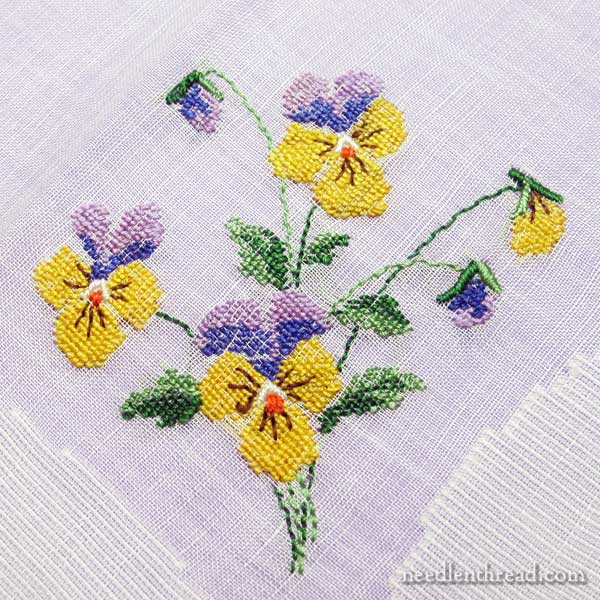
Violas and violets are my absolute favorite flowers. If I could carpet my whole yard with them and decorate my whole house with them, I would!
So when a reader (thank you, Jane!) sent me an amazing assortment of vintage handkerchiefs collected by her mother and grandmother over the years, this little beauty caught my eye right away.
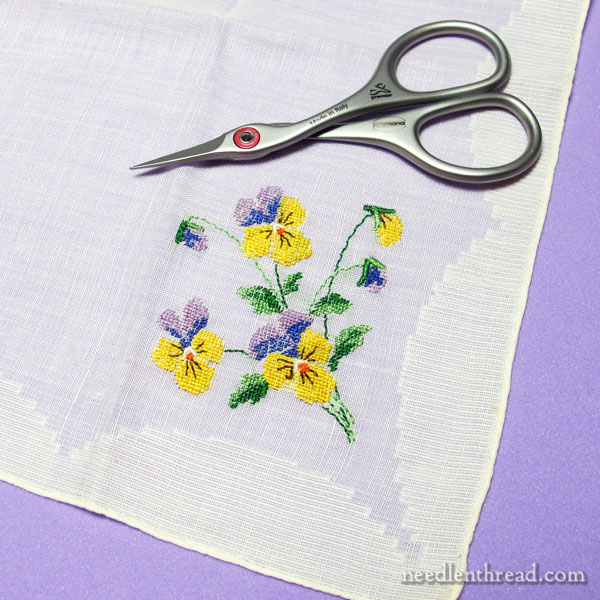
To put the delicacy of the embroidery into better perspective, here’s a pair of embroidery scissors as a gauge. The bunch of violas is not large – just a small corner design on a very finely woven linen ground fabric.
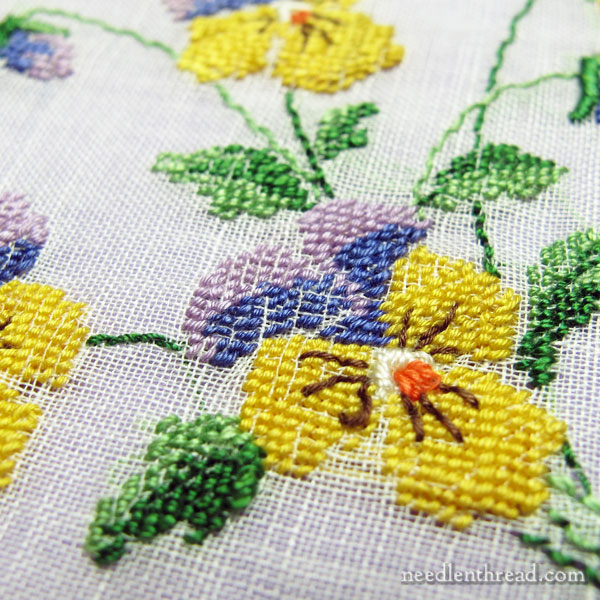
With the exception of a few leaves, the stems, and the accents on the flowers, the whole design is worked in tent stitch.
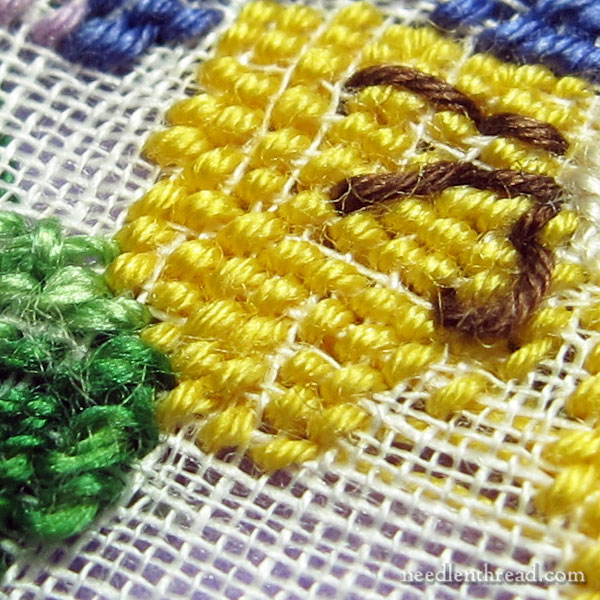
In the close-up above (you can click on the photos for a larger version), you can see that the tent stitch is worked over two fabric threads. The stitches are tiny!
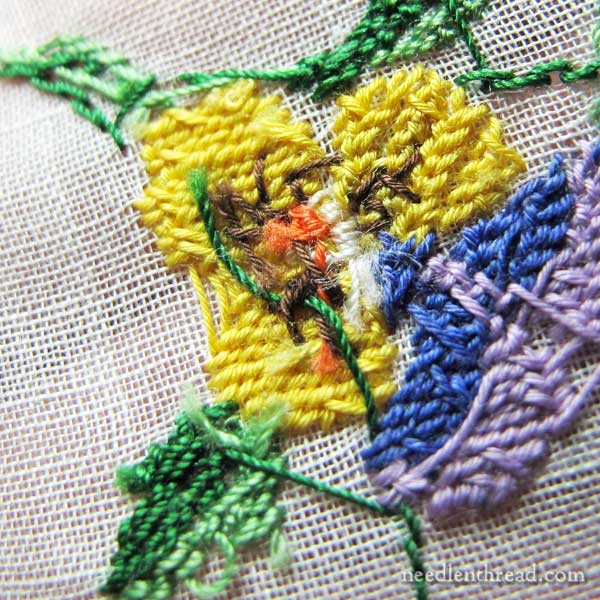
And here’s the back, in its glorious haphazardness.
The thread used is a cotton thread – it looks like coton a broder up close, in a finer size than what we have available in colors today.
I don’t see any evidence of transfer lines, but I’m certain that the design was not a counted or charted design – it was most likely drawn on in pencil (or something that washed away) and the spaces filled with the tent stitch, and then the accents worked over the tent stitch flowers.
The stems are worked in a reverse running stitch. At first I thought they were backstitch or even a cable stitch in some places, but the back of the fabric makes it clear it more of a reverse running stitch (or Holbein stitch), where they’re worked in running stitch first in one direction, leaving spaces between the stitches, and then back along the same path, filling in the spaces.
So there’s your Monday-morning inspiration – and a little shot of spring, mid-February!
Wherever you are, have a wonderful Monday!







Lovely!
So sweet and pretty. I thought it was cross stitch, but your clever close up shows the tent stitch perfectly.
I thought it was petit point when I saw it, what is the difference? a name or actual technique?
Tania
That’s right – it’s petit point, which is done in tent stitch… the stitch name is tent stitch.
Try as I might, I could not decipher those tiny stitches. Thank you, Mary
Oh that made me so happy! Pansies are my favorite too. Thank you Mary for posting all those closeup pictures, so we could really get a good look. (you must have a wonderful camera!) I see these exquisitely embroidered handkerchiefs and wonder how anyone could dare blow their nose on them, but my mom assured me they did!
Dear Mary
What a lovely spring addition to the beginning of the week and what a lovely gift for you and so delicately embroidered. I always imagined that Tent stitch was quite heavy but in this design it’s very delicate a lovely piece. I’m sure this cheered you up when you received such a lovely gift. Thanks for sharing the designed handkerchief with us and I hope you have a great Monday.
Regards Anita Simmance
The handkerchief is very pretty! And thanks to your photography skills, I can actually see how it was done. I’d need a seriously good magnifier and light to do this…
I have been trying to get back to my garden stitchery, but with the frigid north wind howling around the house yesterday, I couldn’t face it!
But the handkerchief is lovely. Maybe your little viola will find a crack in the ice around here!
This hankie is lovely. I too thought it looked like counted cross stitch when I first looked at it, but do see that it is not. I now need to go back and look at all the old hankies I have to see if there are any surprised in the boxes.
Have a good day.
Gay S
Aren’t hankies wonderful? Do you think you might show how to tell the difference between machine done and hand embroidered hankies? I Think I know but then I’m not so sure.
It’s easier to tell on some pieces than on others. We’ll talk about it a little bit when I show you some others in the collection. There are a few definite tells on machine embroidery – for example, carried threads in a definite order around a design (on the back). But there are other tells, too, and I have a couple hankies that will demonstrate one in particular.
So delicate! Is that white border also embroidered? Is it tent stitch, too?
I would also love to know what makes you feel certain that it wasn’t counted. I love looking at old embroidery, and any hints you have on deciphering them would be welcome!
Well, one reason is because it’s on a corner, and it fits the corner – there’s no off-setting of the design or anything. The other is the uncounted nature of the stems.
I just love vintage handkerchiefs and am always on the lookout for them. I actually USE them (I’m not the Jane who shared this beautiful collection with Mary) and because of that friends and acquaintances sometimes give me ones they’ve inherited. They all deteriorate eventually, but they bring me joy during their useful life and I like to think their original owners were delighted with them too.
I’d like to know more about the hem on this piece. I assumed it was hemstitched until I saw the closeup with bars of what looks like stitches. Thank you Jane and Mary for sharing.
Jane, ladies used their delicately embroidered hankies as accessories–peeking from a pocket, carried in the hand–or for dabbing a stray teardrop or sniffle. For a good honk one asked her escort for his or used one’s own ‘everyday’ handkerchief. I believe this is why so many survive.
Handkerchiefs were also considered an appropriate small gift or keepsake for a friend, relative, favorite teacher or pastor’s wife. Hemstitching, crochet edging or embroidery made the gift personal and helped girls practice their needlework skills.
I also have various antique (?) handkerchiefs from my mother and grandmothers. My thought is to sew them together (like quilt panels) to make a wall hanging. What would you suggest as background fabric? Thank you for all the inspirations your blog has.
We do not use disposable paper products in our house. No paper towels, Kleenex, and even our toilet paper is made from bamboo and sugar cane refuse. So onto handkerchiefs. I use them for real. They are not something I collect because they are pretty. When I do my ironing every week I check them out and if one is showing wear or has developed a hole I will put it into my crafting bag. It’s to expensive to buy them signally. I usually buy them in lots on EBay. Over the years I have gotten many done in this same style. Most often pink roses, with full size pansies coming in second. I have never seen a little violet one though, Mary. What a little treasure. Right now in my front garden I have violets blooming and it is 33 degrees. Living in Texas my violets start blooming in the Fall and bloom straight through Spring. The Summer is so hot here that the violets can’t handle it so they hibernate through the Summer.
Considering it’s been -23 degrees celcius here with a windchill in the -30’s, seeing these little violets was a welcome sight!!
Brrrrrrrrrrrrrrr!
Mary, do you have any recommendations for a modern linen that would work well and feel nice as a handkerchief?
Hi, Jen – oh yes! Linen cambric – it’s available through Hedgehog Handworks: http://www.hedgehoghandworks.com/catalog/FAB10900.php – it’s a fine linen and has a soft, wonderful hand. It’s on sale right now, too. I find regular “handkerchief weight” linen to be somewhat stiff and “scratchy” by comparison.
Very pretty, I love violets and violas too. It seems most people do. And lucky you, what a gorgeous gift.
What is the difference between petit point and gros point? Is it just a matter of size or is there something else going on? You can tell I am not much into either thing, can’t you?
It’s the size. When the two are worked together on a piece of Penelope canvas, they both refer to tent stitch – petit point is the smaller tent stitch over the 1/4 thread area and gros point is the larger tent stitch worked over the full intersection.
Thanks, Mary! I appreciate it :-D.
I love❤️❤️❤️